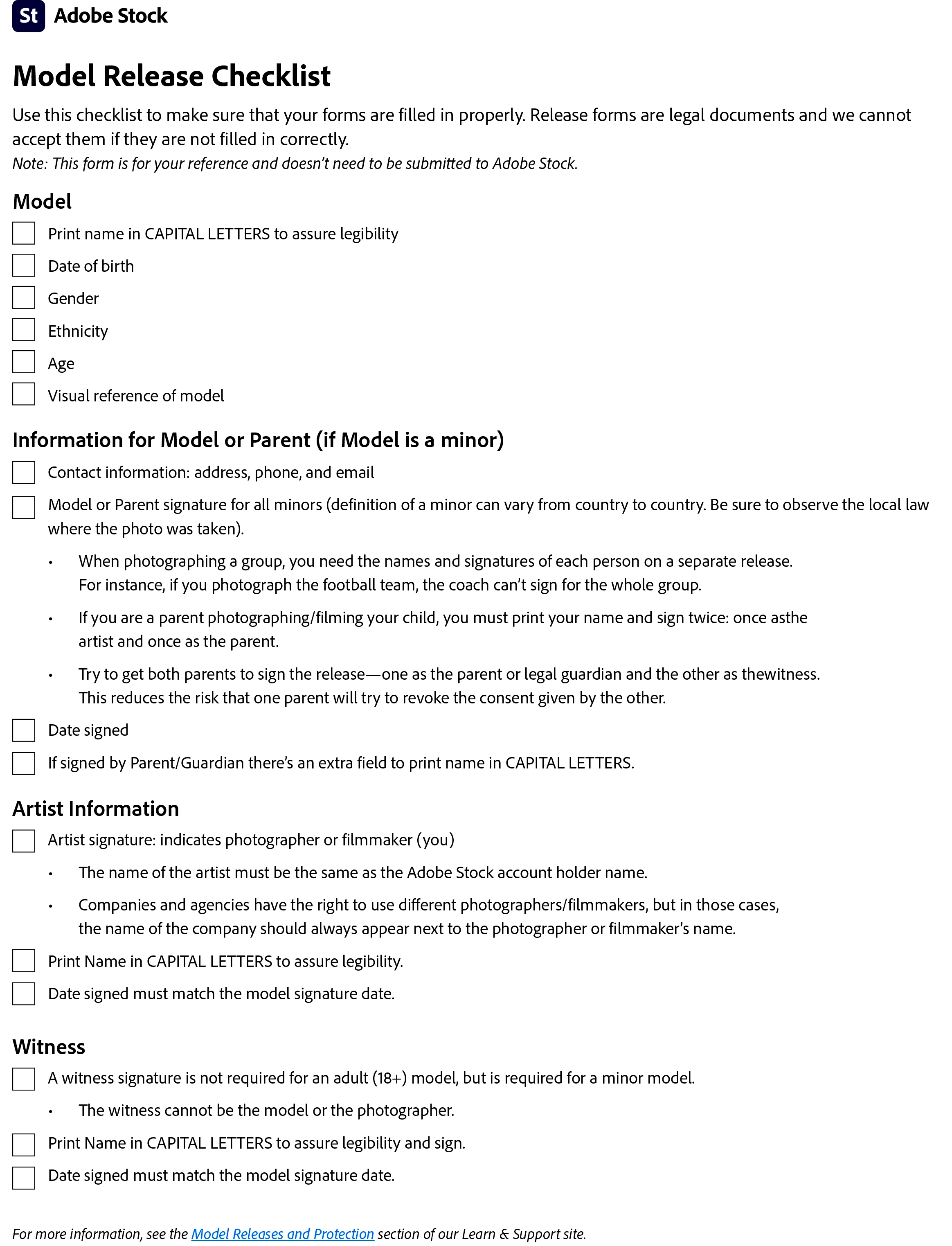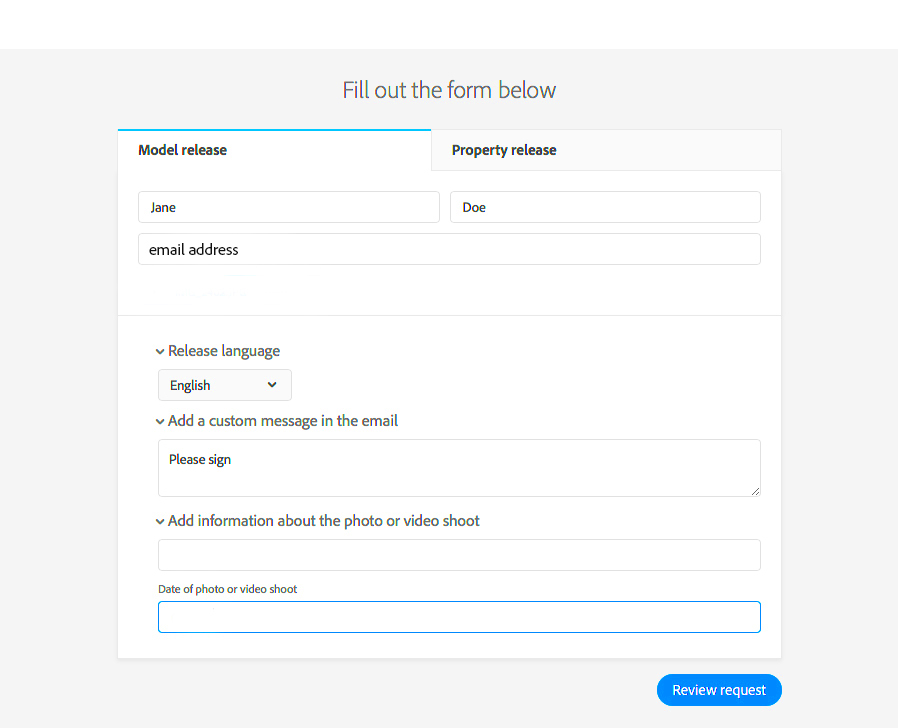As I embraced stock photography I had a taste of bewilderment at the numerous photographs present. But then again, as time went on, I realized that what looked like a great picture was often underpinned by some legalities: particularly the release form. A model release form is an official statement signed beforehand by a person allowing their image or property to be utilized in photographs. Therefore, this gives photographers and image purchasers peace of mind since they don’t have to worry about getting sued.Release forms on
Adobe Stock come as a cushion for the creators and users. They ensure that necessary permissions are obtained thus smoothening transaction processes and making them less tedious. It is important for anyone who deals with stock photos to have knowledge about these forms since they play an important role in maintaining the stock image market place.
Importance of Release Forms for Stock Images

You may spend hours getting the most outstanding shot, and then discover that you cannot use it in any way for commercial purposes because of lack of required permissions. That is where release forms play an important role they provide legal protection making sure that both photographer’s as well as person’s covered.These are some significant reasons as to why release forms are important:
- Legal Protection: They shield photographers from potential lawsuits.
- Credibility: Having a signed release form adds legitimacy to your work.
- Commercial Use: Without a release, you may only be able to use images for personal projects.
Like I said earlier, having a well-formulated release form creates opportunities. This makes me confident in marketing my images because I have a reliable legal contract behind my back.
Types of Release Forms Used in Adobe Stock
 Adobe Stock
Adobe Stock classifies releases into two main types: model releases and property releases. Both of these serve a different purpose; hence, understanding their disparity is very essential.
| Type of Release | Description |
|---|
| Model Release | This is used when a photograph features recognizable individuals. It allows you to use their likeness without any legal issues. |
| Property Release | This form is necessary when the image includes private property, such as a home or business. It ensures that you have permission to use the image commercially. |
Everyone who participates in stock photography should have an in-depth knowledge of these types of release forms. A few months ago, while working on a project, I discovered how important these forms are when my client raised an issue regarding a property that was present in my images. This opened up my eyes on how essential it was to get hold of such releases promptly even if it meant doing so at a hurry. Thus, having the right forms from the beginning can help avoid later chances for waste-time issues or problems.
How to Obtain a Release Form for Your Images

Acquiring an authorization letter can appear scary, however it is more straightforward than it appears. When I started my photographic profession, I didn’t know how to begin. After conducting some research and having informal discussions with other photographers, I discovered that a simple procedure is always the best approach. This article provides a detailed guide on how to go about it without stress.Initially, think about the connection you share with either the object or the legal possessor. This can make it easier if there is a cordial relationship hence can approach them directly. Here are some practical measures:
- Prepare a Template: Having a basic template can save you time. There are many resources online where you can find examples.
- Communicate Clearly: Explain why you need the release. Sharing your vision for the image can help subjects feel more comfortable.
- Get it Signed: Ensure that you collect signatures before using the image. A handshake is nice, but a signed document is crucial!
Based on what I have seen, a little incentive such as a digital version of the photo can make it more appealing, given that it demonstrates appreciation and promotes collaboration. Furthermore, always store securely copies of signed forms both online and offline for reference later on.
Common Mistakes to Avoid with Release Forms
As I have managed to sail through the waters of stock photography, I have encountered several snags that can easily entangle even the most experienced photographers. Therefore, let us talk about mundane blunders to avoid while handling release forms in order for you not to be caught up in their webs.Some examples of errors you might want to be conscious about include:
- Neglecting to Get a Release: This might seem obvious, but sometimes in the excitement of capturing a great shot, we forget to ask for permission. Always prioritize this step!
- Using Incomplete Forms: A signed form without all necessary details can lead to complications. Ensure every blank is filled in, including the date and specific usage rights.
- Not Keeping Records: Failing to store your releases can cause headaches later. I learned this the hard way when I couldn't find a release for an image that had been published.
As I live my life, one of the things that I hold in high esteem is that it is always good to take a few minutes before doing anything rather than regretting later. When you communicate clearly and record in writing there is no way you can be stressed in future.
Legal Implications of Not Using Release Forms
Release forms are more than just papers to sign; they are about self-protection and regard for other people. A friend, who is also a photographer, end up being sued for using someone’s image without their consent once upon a time. All these events should be a big lesson in the society we live in today.The following are some possible legal implications resulting from omission of this indispensable task:
- Infringement Claims: Without a release, subjects may claim their likeness was used without consent, leading to lawsuits.
- Financial Penalties: Legal battles can be expensive, and fines can quickly add up, leaving you financially strained.
- Loss of Reputation: Being embroiled in legal issues can damage your reputation as a photographer, making it harder to collaborate with others.
Such inferences should not be taken lightly. This is because a release form serves as proof of one’s devotion to sound ethical practices. Upon retrospective evaluation, it dawned on me that honoring other people’s rights is the foundation of our profession. Hence through gaining knowledge about and observing these legislative stipulations, stock photography can have a lively and considerate society.
Frequently Asked Questions about Release Forms
When it comes to sorting through release forms, things usually become rather complicated, particularly for novices in photography and stock images. Throughout my career, I have answered similar questions again and again. Therefore, we will try to look at some of these questions in order to make things clearer for people dealing with them.This are some assorted frequently asked questions:
What is the difference between a model release and a property release?
- A model release is used for images featuring recognizable individuals, while a property release is necessary for private property. Knowing which one to use is crucial for legal compliance.
Do I need a release form for every photo I take?
- Not necessarily. If the subject is in a public space where there’s no reasonable expectation of privacy, a release may not be required. However, it’s best to err on the side of caution.
Can I use a digital version of a release form?
- Yes, as long as it’s signed and stored securely. Many photographers now opt for digital signatures for convenience, which can be a lifesaver in this fast-paced world.
What if my subject is a minor?
- In such cases, you’ll need a parent or guardian to sign the release form. Always approach this with sensitivity, as it involves trust and responsibility.
Here are some of the issues that often come up (or so I think), but if we handle them in advance we may avoid wasting time and energy subsequently.
Conclusion on the Role of Release Forms in Adobe Stock
In this dazzling realm of stock images, release forms are not just pieces of paper; they serve as vital instruments for both creators and subjects alike. I have learned from my own experience in photography that if we take our time to comprehend and use these documents, we create an atmosphere of trust and professionalism.Thus respect for individual and property rights protects not only our creations but also aids in developing a more just, equitable and flourishing artistic society.
 You may spend hours getting the most outstanding shot, and then discover that you cannot use it in any way for commercial purposes because of lack of required permissions. That is where release forms play an important role they provide legal protection making sure that both photographer’s as well as person’s covered.These are some significant reasons as to why release forms are important:
You may spend hours getting the most outstanding shot, and then discover that you cannot use it in any way for commercial purposes because of lack of required permissions. That is where release forms play an important role they provide legal protection making sure that both photographer’s as well as person’s covered.These are some significant reasons as to why release forms are important: Adobe Stock classifies releases into two main types: model releases and property releases. Both of these serve a different purpose; hence, understanding their disparity is very essential.
Adobe Stock classifies releases into two main types: model releases and property releases. Both of these serve a different purpose; hence, understanding their disparity is very essential. Acquiring an authorization letter can appear scary, however it is more straightforward than it appears. When I started my photographic profession, I didn’t know how to begin. After conducting some research and having informal discussions with other photographers, I discovered that a simple procedure is always the best approach. This article provides a detailed guide on how to go about it without stress.Initially, think about the connection you share with either the object or the legal possessor. This can make it easier if there is a cordial relationship hence can approach them directly. Here are some practical measures:
Acquiring an authorization letter can appear scary, however it is more straightforward than it appears. When I started my photographic profession, I didn’t know how to begin. After conducting some research and having informal discussions with other photographers, I discovered that a simple procedure is always the best approach. This article provides a detailed guide on how to go about it without stress.Initially, think about the connection you share with either the object or the legal possessor. This can make it easier if there is a cordial relationship hence can approach them directly. Here are some practical measures:
 admin
admin








